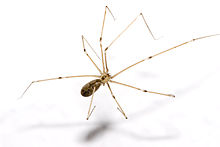Synspermiata
| Synspermiata Temporal range:
| |
|---|---|

| |
| Pholcus phalangioides (Pholcidae) | |
| Scientific classification | |
| Domain: | Eukaryota |
| Kingdom: | Animalia |
| Phylum: | Arthropoda |
| Subphylum: | Chelicerata |
| Class: | Arachnida |
| Order: | Araneae |
| Infraorder: | Araneomorphae |
| Clade: | Synspermiata |
| Families | |
|
See text. | |
Synspermiata is a clade of araneomorph spiders, comprising most of the former "haplogynes". They are united by having simpler genitalia than other araneomorph spiders, lacking a cribellum, and sharing an evolutionary history of synspermia – a particular way in which spermatozoa are grouped together when transferred to the female.[1][2]
Synspermia
Spermatozoa are produced in a multi-step process. A primary spermatocyte with the full diploid number of chromosomes divides to form two secondary spermatocytes which are haploid, i.e. each has half the diploid number of chromosomes. Each secondary spermatocyte then divides to produce two spermatids which undergo further development to form spermatozoa.[3] In synspermia, two or more spermatids from the same spermatocyte fuse together and are enclosed in an envelope, forming a "capsule". This contrasts with cleistospermia, where the capsules enclose individual spermatozoa. After transfer to the female in either form, decapsulation and activation are necessary before the resulting spermatozoa can fertilize eggs.[1]
Phylogeny
In 2014, Peter Michalik and Martín Ramírez published a study of the morphology of the reproductive system of male spiders, including their spermatozoa. They found a
A much larger
| Araneomorphae |
| ||||||||||||||||||
Families
Families placed in Synspermiata are:[1][2]
- Caponiidae
- Diguetidae
- Drymusidae
- Dysderidae
- Ochyroceratidae
- Oonopidae
- Orsolobidae
- Pacullidae
- Periegopidae
- Pholcidae
- Plectreuridae
- Scytodidae
- Segestriidae
- Sicariidae
- Telemidae
- Tetrablemmidae
- Trogloraptoridae
Extinct families
(Telemidae was not included in the analysis by Wheeler et al.,[2] but is placed in Synspermiata in other studies.[1]
References
- ^ PMID 24907603
- ^
- ^ "The Spermatozoön – Human Anatomy", Gray's Anatomy on theodora.com, retrieved 2017-04-30
